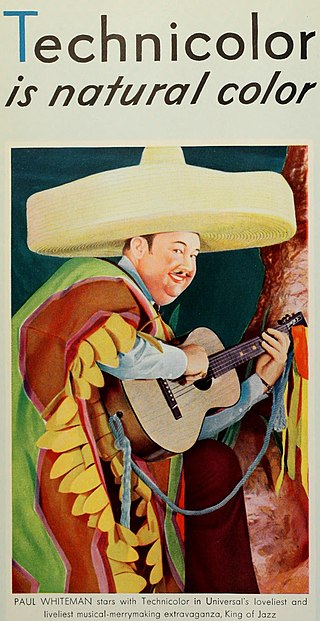
35 mm film is a film gauge used in filmmaking, and the film standard. In motion pictures that record on film, 35 mm is the most commonly used gauge. The name of the gauge is not a direct measurement, and refers to the nominal width of the 35 mm format photographic film, which consists of strips 1.377 ± 0.001 inches (34.976 ± 0.025 mm) wide. The standard image exposure length on 35 mm for movies is four perforations per frame along both edges, which results in 16 frames per foot of film.
Vantiva SA, formerly Technicolor SA, Thomson SARL, Thomson SA, and Thomson Multimedia, is a French multinational corporation that provides creative services and technology products for the communication, media and entertainment industries. Vantiva's headquarters are located in Paris, France. Other main office locations include Norcross (USA), Rennes (France) Edegem (Belgium) Seoul, Beijing (China), Chennai (India), Memphis (USA).

Solomon Max Wurtzel was an American film producer.

Cinecolor was an early subtractive color-model two-color motion picture process that was based upon the Prizma system of the 1910s and 1920s and the Multicolor system of the late 1920s and the 1930s. It was developed by William T. Crispinel and Alan M. Gundelfinger, and its various formats were in use from 1932 to 1955.

Mystery of the Wax Museum is a 1933 American pre-Code mystery-horror film directed by Michael Curtiz and starring Lionel Atwill, Fay Wray, Glenda Farrell, and Frank McHugh. It was produced and released by Warner Bros. and filmed in two-color Technicolor; Doctor X and Mystery of the Wax Museum were the last two dramatic fiction films made using this process.

Petro Vlahos was an American engineer and inventor, considered to be one of the pioneering scientific and technical innovators of the motion picture and television industries. He is remembered in particular for creating the Ultimatte process, which refined the colour process known as chroma keying. In recognition of his contributions, he was awarded multiple Oscars, as well as an Emmy Award.
Consolidated Film Industries was a film laboratory and film processing company and was one of the leading film laboratories in the Los Angeles area for many decades. CFI processed negatives and made prints for motion pictures and television. The company and its employees received many Academy Awards for scientific or technical achievements.
An internegative is a motion picture film duplicate. It is the color counterpart to an interpositive, in which a low-contrast color image is used as the positive between an original camera negative and a duplicate negative.

Color motion picture film refers both to unexposed color photographic film in a format suitable for use in a motion picture camera, and to finished motion picture film, ready for use in a projector, which bears images in color.
Eastmancolor is a trade name used by Eastman Kodak for a number of related film and processing technologies associated with color motion picture production and referring to George Eastman, founder of Kodak.
Trucolor was a color motion picture process used and owned by the Consolidated Film Industries division of Republic Pictures. It was introduced as a replacement for Consolidated's own Magnacolor process.
Dye transfer is a continuous-tone color photographic printing process. It was used to print Technicolor films, as well as to produce paper colour prints used in advertising, or large transparencies for display.

Deluxe Media Inc., also known simply as Deluxe and formerly Deluxe Entertainment Services Group, Inc., is an American multinational multimedia and entertainment service provisions company owned by Platinum Equity, founded in 1915 by Hungarian-born American film producer William Fox and headquartered in Burbank, California.
In bipack color photography for motion pictures, two strips of black-and-white 35 mm film, running through the camera emulsion to emulsion, are used to record two regions of the color spectrum, for the purpose of ultimately printing the images, in complementary colors, superimposed on one strip of film. The result is a multicolored projection print that reproduces a useful but limited range of color by the subtractive color method. Bipack processes became commercially practical in the early 1910s when Kodak introduced duplitized film print stock, which facilitated making two-color prints.
Natural color was a term used in the beginning of film and later on in the 1920s, and early 1930s as a color film process that actually filmed color images, rather than a color tinted or colorized movie. The first natural color processes were in the 1900s and 1910s and were two color additive color processes or red and green missing primary color blue, one additive process of time was Kinemacolor. By the 1920s, subtractive color was mostly in use with such processes as Technicolor, Prizma and Multicolor, but Multicolor was mostly never in use in the late 1920s, Technicolor was mostly in use. The only one who cared to mess with Multicolor was William Fox, probably because Multicolor was more cheaper of a process and at the time in 1929 William Fox was in debt. The difference between additive color and subtractive color were that an additive color film required a special projector that could project two components of film at the same time, a green record and a red record. But additive color didn't required a special projector, the two pieces of film were chemically formed together and was projected in one strip of film.

Technicolor is a series of color motion picture processes, the first version dating back to 1916, and followed by improved versions over several decades.
Alan Eliot Freedman was a pioneer and long-time executive in the motion picture film processing industry. He founded DeLuxe Laboratories after serving as president of its predecessor, Fox Film Laboratories. His career lasted over 50 years.







